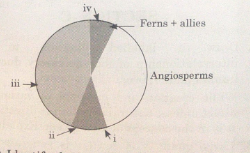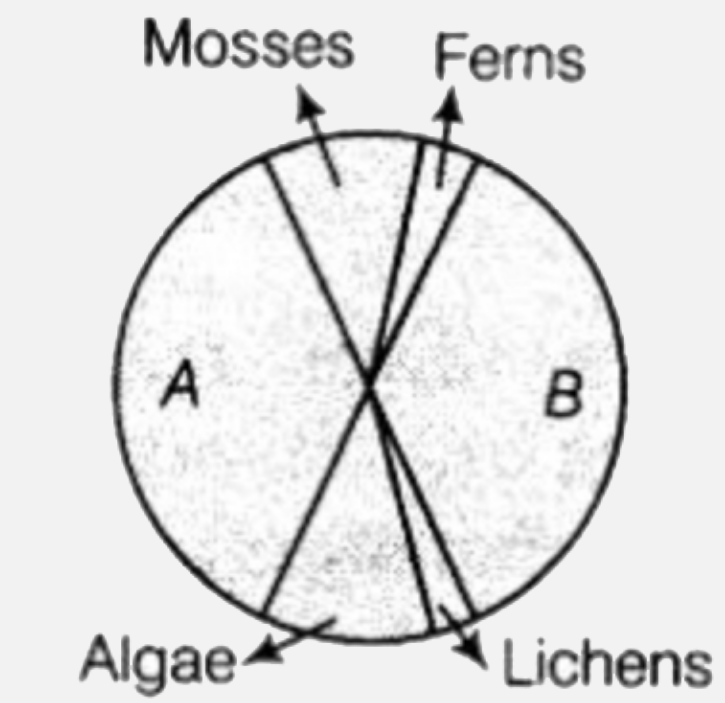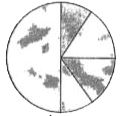Below pie diagram shows the global biodiversity and proportionate numbers of vertebrates. Identify the markings if :I. Fishes II. AmphibiansIII. Mammals IV. BirdsV. ReptilesABCDEaIIIIIIIVVbVIIIIIVIIcIIIIVVIIIdIIVIIIIIV
Related Solutions
Identify the areas labelled (i), (ii), (iii) and (iv) in the pie chart given below representing the biodiversity of plants showing their proportionate number of species of major taxa.
 View Solution
View SolutionIndentify the areas labellel as I, ii, iii, and iv in the pie chart given below representing the biodiversity of plants showing their proportionate number of species of major taxa.
 View Solution
View SolutionIndentify the areas labelled (i), (ii), (iii) and (iv) in the pie chart given below representing the biodiversity of plants showing their proportionate number of species of major taxa.
 View Solution
View SolutionName the unlabelled areas 'a' and 'b' of the pie chart representing biodiversity of vertebrates showing the proportionate number of species of major taxa.
 View Solution
View SolutionGlobal biodiversity representing proportionate number of species of major taxa of invertebrates, vertbrates and plants are given below , Identify I,II and III by selecting the correct option :
 View Solution
View SolutionThe given pie diagram represents the proportionate number of species of major taxa of vertebrates. Identify the group A and B.
 View Solution
View SolutionThe given pie diagram represents the proportionate number of species of major taxa of vertebrates. Identify the group A and B.
 View Solution
View SolutionThe given pie diagram represents the proportionate number of species of major taxa of vertebrates. Identify the group A and B.
 View Solution
View SolutionThe following are pie diagrams A, B and C related to proportionate number of species of major taxa of invertebrates, vertebrates and plants repectively. Study and select the right option in which all the blanks I, II, III and IV are correctly identified
View SolutionGiven below are pie diagrams A, B and C related to proportionate number of species of major taxa of invertebrates, vartebrates and plants respectively. Critically study and fill in the blanks (a), (b), (c ) and (d).
 View Solution
View SolutionStudy the given diagram and answer the following :

Name the labelled area 'a' and 'b' of the pie diagram representing the global biodiversity of invertebrates showing their proportionate number of species of major taxa.View SolutionIdentify the groups of organism marked A and B in the given pie diagram representing the proportionate number of species of major taxa of plants.
View SolutionIdentify the groups of organism marked A and B in the given pie diagram representing the proportionate number of species of major taxa of plants.
View SolutionName the unlabeled areas 'a' and 'b' of the pie chart (given above) representing the global biodiversity of invertebrates showing their proportionate number of species of major taxa.
 View Solution
View SolutionObserve the pie chart given below showing biodiversity and identify 'a' and 'b'
 View Solution
View Solutionदिया गया पाई चित्र वर्टीब्रेट्स के मुख्य वर्गक की जातियों की समानुपाती संख्याओं को दर्शाता है | समूह A और B को पहचानें |
 View Solution
View Solutionनिम्न चित्र का अवलोकन कर चिन्हित लाइन्स (i), (ii), (iii) तथा (iv) को पहचानिए
 View Solution
View SolutionIn the global biodiversity of vertebrates, the major contributors are
 View Solution
View SolutionName the unlabelled areas 'A' and 'B' of the pie chart representing the biodiversity of plants showing their proportionate number of species of major taxa.
View SolutionName the unlabelled areas 'a' and 'b' of the pie chart representing the biodiversity of plants showing their proportionate number of species of major taxa.
View Solution
